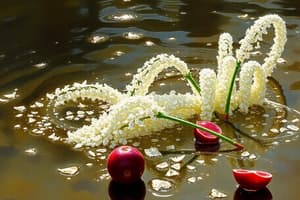Podcast
Questions and Answers
Define Water Activity (Aw) and explain how it is calculated.
Define Water Activity (Aw) and explain how it is calculated.
Water activity is the equilibrium property of water at a given temperature and moisture content, defined as the relative vapor pressure (RVP) at that temperature. It is calculated as aw = p/po, where p is the partial pressure of water vapor at the surface of the product and po is the saturation pressure or the partial pressure of water vapor above pure water at the same temperature.
Which of the following best describes the relationship between water activity and water content in a food sample?
Which of the following best describes the relationship between water activity and water content in a food sample?
- Water activity decreases as water content increases.
- Water activity and water content can be related, but they are not the same. (correct)
- Water content is always directly proportional to water activity.
- Water activity is a measure of total water content in a sample.
Water activity is only influenced by temperature when water content changes.
Water activity is only influenced by temperature when water content changes.
False (B)
In moisture sorption isotherms, the relationship between __________ and equilibrium moisture content is studied.
In moisture sorption isotherms, the relationship between __________ and equilibrium moisture content is studied.
Match the food material with its corresponding category in moisture sorption isotherms:
Match the food material with its corresponding category in moisture sorption isotherms:
Flashcards are hidden until you start studying
Study Notes
Water Activity (Aw)
- Water content alone is not a reliable indicator of perishability, as it relates to the intensity of water association with non-aqueous constituents.
- Bound water is less able to support degradative activities like microbial growth or hydrolytic chemical reactions.
- Aw is an intrinsic property of the sample, defined as the equilibrium property of water at a given temperature and moisture content, or relative vapour pressure (RVP).
Definition of Water Activity
- Aw is defined as p/po, where p is the partial pressure of water vapour at the surface of the product, and po is the saturation pressure, or the partial pressure of water vapour above pure water at the same temperature.
- Aw can also be expressed as ERH/100, where ERH is the Equilibrium Relative Humidity property of the atmosphere in equilibrium with the sample.
Measurement of Water Activity
- RVP can be determined by placing the sample in a closed chamber for a time sufficient to achieve apparent equilibrium (constant weight) and then measuring either pressure or relative humidity.
Characteristics of Water Activity
- Water activity is not a measure of free water vs bound water; a value of Aw = 0.8 does not mean 80% free and 20% bound water, but rather that the vapor pressure is lower than that of pure water due to some interactions.
- Water activity is temperature dependent, and changes in temperature affect water binding, dissociation of water, solubility of solutes in water, or the state of the matrix.
- The effect of temperature on the water activity of a food is product-specific, and some products increase water activity with increasing temperature, while others decrease Aw with increasing temperature.
Moisture Content
- Moisture content is a quantitative measure of the amount of water in a sample, and is an empirical measurement with no standard.
- Primary methods for measuring moisture content include Loss on Drying and Titration.
Microbial Growth and Water Activity
- Microbial growth is influenced by water activity, and the Cheese & Cracker System experiment demonstrates the relationship between moisture content and water activity.
Moisture Sorption Isotherm (MSI)
- MSI is a measure of the change in free energy of water in a food material, and is a function of water activity and moisture content.
- MSI can be used to assess the thermodynamic status of water in a food material, and relate it to chemical and physical changes, as well as microbial spoilage of foods.
Interpretation of MSI
- MSI is a nonlinear relationship between water content and water activity, with a sigmoidal shape that suggests water exists in different coupled states in foods at different water content levels.
- MSI can be divided into three regions, and is dependent on the composition of the food material and the phase states of the components.
Classification of Water States in Foods
- Classes of water in foods include constitutional, dilution, and capillary water, each with distinct characteristics and proportions.
Powder Flow and Caking
- Powder flow and caking are influenced by water activity, time, and temperature, and are a problem in the food and pharmaceutical industries.
Water Activity and Food Stability
- Water activity affects chemical stability, and reaction rates increase as water activity increases from the monolayer value.
- Common reactions related to chemical stability include Maillard browning, lipid oxidation, hydrolysis, nutrient degradation, and enzymatic reactions.
Controlling Water Activity
- Methods for controlling water activity include dehydration, additives, edible films and coatings, and product formulation.
- Humectants, such as salt, sugars, glycols, amino acids, acids, and polymers, can be used to control water activity.
Studying That Suits You
Use AI to generate personalized quizzes and flashcards to suit your learning preferences.




